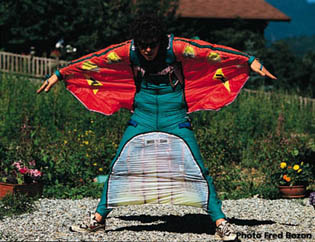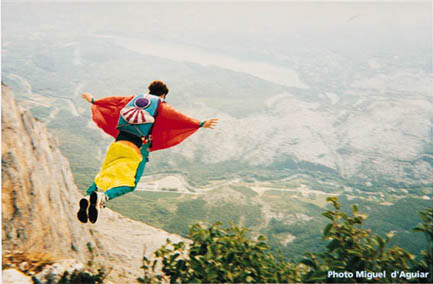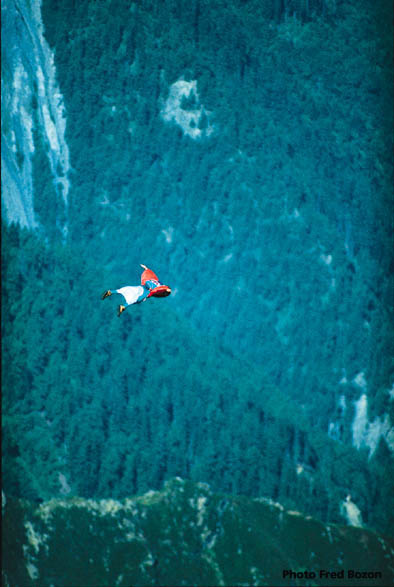Article of the month :
Wing "again"...
Some thought it would happen, some did not...
The wing suit technique designed by Patrick de Gayardon is being used by
a few other skydivers. We met one of them: Jean-Noël Itzstein. His
approach is purely technical, he does not want to copy what has already
been done but to satisfy the same desire to fly an extreme flight. Here
are his explanations.
Interview par ParaMag
ParaMag : Besides the risks inherent to this
kind of jumps, there is the risk of being seen as a copycat, only a few
months after Deug's death. What is your opinion ?
Jean-Noël Itzstein
: I got the idea of jumping with wings
during a movie shooting with Patrick de Gayardon, in Norway for Sector.
I filmed his first BASE jump with wings. I left just on top of him, after
4 or 5 seconds of freefall he stretched out his wings entirely. One second
after that, I could not see him anymore. I finished the jump alone. Once
under canopy, I was wondering where he was and then I saw him pull about
15 seconds later but 300 metres from me, amazing! I wanted to try and I
talked with him: as I am able to sew, he proposed that I work by myself.
The suit would then faster get better. He simply gave me the basic rules
and told me what errors to avoid.
When did you start jumping with wings ?
In November 97 at Deland. With the big clouds there,
I had a lot of fun although the aerodynamic efficiency was around 1.5.
I then took advice from a friend working with ITV. His name is Patrick
Petrini, and he's in charge of developing their canopies. He has made a
total of about 100 plane jumps and was very helpful. We designed my second
wingsuit together. My estimate of the aerodynamic efficiency is close to
2.5.

What are the differences with Patrick de Gayardon's
suit ?
My arms are set more forward so the bearing surface
is greater. The leading edge is also different, so are some other little
things. After several jumps very close to the mountains (Aiguille du Midi
and Col des Drus) in Chamonix last June, we changed the wings between the
legs. We gave up the idea of a deflector which had already given Deug some
trouble before his fatal accident. That's why we have put this wing closer
to the container in order to stick back the flow behind it. The next suit
should be available soon with a total integration of the rig into the profile.
Compared to Deug, I fly more slowly on track, but with a better fall rate.
I think it is the only hope to land with the suit. Deug used to fly at
more than 120 knots, it seems to me it is then impossible to be in control
when getting closer to the ground.

How many jumps did you make with these suits
?
200 or so, 15 of which at Chamonix, about 10 at the
Aiguille du Midi and 2 over the Drus. We are now working on a suit that
should allow an aerodynamic efficiency of 3 or 4. There should also be
a suit " for everybody " but with an aerodynamic efficiency of only 1.5
because it will be a very simple design.

The right equipment is not enough to fly well,
one also needs the right technique...
The jumps at Chamonix were profitable for my flying technique. Near the
Aiguille du Midi, I was 50 metres away from the rocks on my side and 50
metres over the ground. This situation would last for 7 to 8 seconds during
which I could not pull, just fly on my path. I would then either go towards
the valley or go on following the mountain until the end of the rock face,
staying 100 or 200 metres above the ground. This would last for a minute
and I would really feel like I was flying. I would then pull at about 200
metres.
This game has already cost lives, doesn't it
scare you ?
Jumps close to the ground demand a solid BASE jump experience. One can
tell by the incidents and accidents which happened during the Sector shooting
with the wing suits. I have made a bit more than 700 BASE jumps and thus
have the necessary altitude awareness to be able to fly for 1 minute between
100 and 200 metres above ground level. On my first jumps over the spur,
I was feeling like I was at pulling altitude at every moment. For this
kind of jumps, I use a Racer harness with a modified reserve container
and a modified deployment bag for the main (big size).
You talk about BASE jumping with the wings,
have you already tried it ?
I made some cliff jumps in Italy. I used a suit with a setting a bit different
than the one for plane jumps. On the latter suit, the wing is very close
to the handle and it is covered by a part of the trailing edge! I am going
to fix that because it is not very pleasant...It is true that being able
to reach neighbouring slopes and cliffs allows BASE jumps where one could
only fall for a few seconds. Some BASE jumpers think it is a revolution
concerning the great BASE jumps. As for me, it is just a necessary step
in order to fly closer and closer to the ground. I think I can get enough
experience to follow slopes at low altitude and work out a very low approach.
Let us be careful, though : for this kind of jumps, the norms are changed.
" Very low " has a different meaning here than for plane jumps. When I
say " very low ", I mean around 50 metres above the ground or even lower.

In my opinion, it is worth BASE jumping with these wings only to go
to new cliffs or to get more freefall time, for instance on a 300 metres
jump. This suit is constraining on opening and on some occasions, I already
had to cut-away the wings to fight twists with an uncontrolled spin. This
is the reason why
I use a special rig for my jumps in the mountains.
Back to plane jumps, do you think that a greater
number of skydivers will use wings ?
Many skydivers would like to jump with wings. It only adds another constraint
at pulling altitude, just like when jumping with a board. Jumps over mountains
and close to the ground are not for everybody and the same goes for BASE
jumps. That's why we may develop with ITV an easy to use suit, designed
to have fun jumping from a plane. However, I will go on making research
on my suit in order to have a greater aerodynamic efficiency, this will
allow to fly closer to the ground and maybe someday to touch it softly...!
This is just the beginning.

Warning: the English translations in this text may not all be correct.
Thanks for your comprehension and please address any comment to me Jean-Francois
RIPOCHE.





